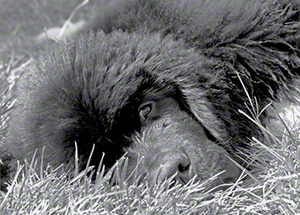by Lisa Allen-VanCouvering
Your breeder strongly recommended you purchase a crate for a puppy and told you why. Even though you understand that it is for the safety of your dog you still aren't quite sure you want your dog in a cage. Firstly, it is not a cage. It is a crate, a kennel, a little house, a room, a bed, whatever you want to call it - anything but a cage. A cage is something that animals are never let out of. A crate is used for the safety and comfort of a dog. When your puppy is not in his crate, notice where he chooses to sleep: under the coffee or dining room table; in the little space between your couch and the wall; in a comer somewhere out of the way. Why? Because your dog is a "den dwelling animal". Dens provide safety and solace, and your dog will come to think of his crate as such.
1) A crate is your dogs seat belt.
a) A crated dog cannot interfere with your driving.
b) In an accident, your dog needs something to prevent it from becoming a flying object.
c) A crate keeps your dog confined should your doors pop open.
2) A crate is your puppy's bed where he will sleep securely during the night, safe and sound.
3) A crate is where your puppy will stay when unattended and in the house. This prevents puppy from destroying and soiling in your house; consuming noxious plants or garbage and escaping out the house through a forgotten, open door.
4) A crate is a safe haven where puppy can escape to when the world is just too much (kids, cats, illness, etc.)
5) A crate is NOT to be used for punishment - EVER!
Purchase your crate before bringing your puppy home. Place the crate in an area where the family spends most of their time like the kitchen or the family room. The goal being to confine the puppy without isolating him from his family. At night, it can be consoling for the pup to sleep in his crate placed in a bedroom of one of his family members. Once again, the pack, den dwelling animal instinct being satisfied. Encourage the pup to enter his crate by rewarding him each time with a small edible treat (remember, a growing pup is always watching his weight). Favorite toys in the crate will also ease the transition of acceptance.
Feeding a pup while crated will further enhance the feeling of comfort and security. Make sure that the puppy is allowed to relieve himself outside before any crating, especially at bedtime. Do rush puppy out first thing in the morning. Remember, he is just a baby and will have to go out to potty early. And, don't worry about the pup when you hear him complaining about his new confinement. Do not rush to console him because that is exactly what he wants you to do. You will be encouraging him to continue barking and he will be effectively training you to rush to his rescue !
There are many different kinds of crates and it can be very confusing when trying to pick one out. Don't buy a small crate because your puppy will be very large at the end of his first year. Buy a crate that will fit a full grown Newf. The crate should be large enough that, when full grown, your dog can stand up, turn around and lie down comfortably. Do not buy a plastic crate. While they are easy to clean, they are also easy to chew and do not provide enough ventilation. A sturdy wire crate with good door latches is your best bet. Be advised though, a good crate is expensive ($100 - $200) but it is an investment for the life of your dog that is well worth it.
Read More About Crate Training:
- Gearing Up for Puppy - Crates
- The Importance of Crate Training
- Crate Training for Safety and Comfort

